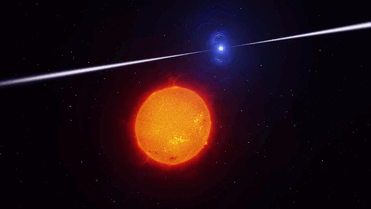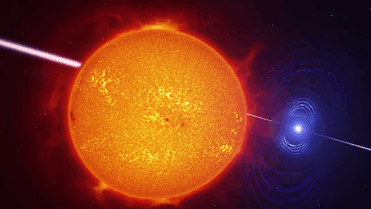Three Ways To Travel At (Nearly) The Speed Of Light
Three Ways to Travel at (Nearly) the Speed of Light

One hundred years ago, Einstein’s theory of general relativity was supported by the results of a solar eclipse experiment. Even before that, Einstein had developed the theory of special relativity — a way of understanding how light travels through space.
Particles of light — photons — travel through a vacuum at a constant pace of more than 670 million miles per hour.

All across space, from black holes to our near-Earth environment, particles are being accelerated to incredible speeds — some even reaching 99.9% the speed of light! By studying these super fast particles, we can learn more about our galactic neighborhood.
Here are three ways particles can accelerate:
1) Electromagnetic Fields!
Electromagnetic fields are the same forces that keep magnets on your fridge! The two components — electric and magnetic fields — work together to whisk particles at super fast speeds throughout the universe. In the right conditions, electromagnetic fields can accelerate particles at near-light-speed.

We can harness electric fields to accelerate particles to similar speeds on Earth! Particle accelerators, like the Large Hadron Collider and Fermilab, use pulsed electromagnetic fields to smash together particles and produce collisions with immense amounts of energy. These experiments help scientists understand the Big Bang and how it shaped the universe!
2) Magnetic Explosions!

Magnetic fields are everywhere in space, encircling Earth and spanning the solar system. When these magnetic fields run into each other, they can become tangled. When the tension between the crossed lines becomes too great, the lines explosively snap and realign in a process known as magnetic reconnection. Scientists suspect this is one way that particles — for example, the solar wind, which is the constant stream of charged particles from the Sun — are sped up to super fast speeds.

When magnetic reconnection occurs on the side of Earth facing away from the Sun, the particles can be hurled into Earth’s upper atmosphere where they spark the auroras.
3) Wave-Particle Interactions!

Particles can be accelerated by interactions with electromagnetic waves, called wave-particle interactions. When electromagnetic waves collide, their fields can become compressed. Charged particles bounce back and forth between the waves, like a ball bouncing between two merging walls. These types of interactions are constantly occurring in near-Earth space and are responsible for damaging electronics on spacecraft and satellites in space.

Wave-particle interactions might also be responsible for accelerating some cosmic rays from outside our solar system. After a supernova explosion, a hot, dense shell of compressed gas called a blast wave is ejected away from the stellar core. Wave-particle interactions in these bubbles can launch high-energy cosmic rays at 99.6% the speed of light.
Make sure to follow us on Tumblr for your regular dose of space: http://nasa.tumblr.com.
More Posts from Ocrim1967 and Others
10 Steps to Confirm a Planet Around Another Star
So you think you found an exoplanet – a planet around another star? It’s not as simple as pointing a telescope to the sky and looking for a planet that waves back. Scientists gather many observations and carefully analyze their data before they can be even somewhat sure that they’ve discovered new worlds.
Here are 10 things to know about finding and confirming exoplanets.

This is an illustration of the different elements in our exoplanet program, including ground-based observatories, like the W. M. Keck Observatory, and space-based observatories like Hubble, Spitzer, Kepler, TESS, James Webb Space Telescope, WFIRST and future missions.
1. Pick your tool to take a look.
The vast majority of planets around other stars have been found through the transit method so far. This technique involves monitoring the amount of light that a star gives off over time, and looking for dips in brightness that may indicate an orbiting planet passing in front of the star.
We have two specialized exoplanet-hunting telescopes scanning the sky for new planets right now – Kepler and the Transiting Exoplanet Survey Satellite (TESS) – and they both work this way. Other methods of finding exoplanets include radial velocity (looking for a “wobble” in a star’s position caused by a planet’s gravity), direct imaging (blocking the light of the star to see the planet) and microlensing (watching for events where a star passes in front of another star, and the gravity of the first star acts as a lens).
Here’s more about finding exoplanets.

2. Get the data.
To find a planet, scientists need to get data from telescopes, whether those telescopes are in space or on the ground. But telescopes don’t capture photos of planets with nametags. Instead, telescopes designed for the transit method show us how brightly thousands of stars are shining over time. TESS, which launched in April and just began collecting science data, beams its stellar observations back to Earth through our Deep Space Network, and then scientists get to work.

3. Scan the data for planets.
Researchers combing through TESS data are looking for those transit events that could indicate planets around other stars. If the star’s light lessens by the same amount on a regular basis – for example, every 10 days – this may indicate a planet with an orbital period (or “year”) of 10 days. The standard requirement for planet candidates from TESS is at least two transits – that is, two equal dips in brightness from the same star.

4. Make sure the planet signature couldn’t be something else.
Not all dips in a star’s brightness are caused by transiting planets. There may be another object – such as a companion star, a group of asteroids, a cloud of dust or a failed star called a brown dwarf, that makes a regular trip around the target star. There could also be something funky going on with the telescope’s behavior, how it delivered the data, or other “artifacts” in data that just aren’t planets. Scientists must rule out all non-planet options to the best of their ability before moving forward.

5. Follow up with a second detection method.
Finding the same planet candidate using two different techniques is a strong sign that the planet exists, and is the standard for “confirming” a planet. That’s why a vast network of ground-based telescopes will be looking for the same planet candidates that TESS discovers. It is also possible that TESS will spot a planet candidate already detected by another telescope in the past. With these combined observations, the planet could then be confirmed. The first planet TESS discovered, Pi Mensae c, orbits a star previously observed with the radial-velocity method on the ground. Scientists compared the TESS data and the radial-velocity data from that star to confirm the presence of planet “c.”
Scientists using the radial-velocity detection method see a star’s wobble caused by a planet’s gravity, and can rule out other kinds of objects such as companion stars. Radial-velocity detection also allows scientists to calculate the mass of the planet.

6. …or at least another telescope.
Other space telescopes may also be used to help confirm exoplanets, characterize them and even discover additional planets around the same stars. If the planet is detected by the same method, but by two different telescopes, and has received enough scrutiny that the scientists are more than 99 percent sure it’s a planet, it is said to be “validated” instead of “confirmed.”

7. Write a paper.
After thoroughly analyzing the data, and running tests to make sure that their result still looks like the signature of a planet, scientists write a formal paper describing their findings. Using the transit method, they can also report the size of the planet. The planet’s radius is related to how much light it blocks from the star, as well as the size of the star itself. The scientists then submit the study to a journal.

8. Wait for peer review.
Scientific journals have a rigorous peer review process. This means scientific experts not involved in the study review it and make sure the findings look sound. The peer-reviewers may have questions or suggestions for the scientists. When everyone agrees on a version of the study, it gets published.
9. Publish the study.
When the study is published, scientists can officially say they have found a new planet. This may still not be the end of the story, however. For example, the TRAPPIST telescope in Chile first thought they had discovered three Earth-size planets in the TRAPPIST-1 system. When our Spitzer Space Telescope and other ground-based telescopes followed up, they found that one of the original reported planets (the original TRAPPIST-1d) did not exist, but they discovered five others –bringing the total up to seven wondrous rocky worlds.

10. Catalog and celebrate – and look closer if you can!
Confirmed planets get added to our official catalog. So far, Kepler has sent back the biggest bounty of confirmed exoplanets of any telescope – more than 2,600 to date. TESS, which just began its planet search, is expected to discover many thousands more. Ground-based follow-up will help determine if these planets are gaseous or rocky, and possibly more about their atmospheres. The forthcoming James Webb Space Telescope will be able to take a deeper look at the atmospheres of the most interesting TESS discoveries.
Scientists sometimes even uncover planets with the help of people like you: exoplanet K2-138 was discovered through citizen scientists in Kepler’s K2 mission data. Based on surveys so far, scientists calculate that almost every star in the Milky Way should have at least one planet. That makes billions more, waiting to be found! Stay up to date with our latest discoveries using this exoplanet counter.
Make sure to follow us on Tumblr for your regular dose of space: http://nasa.tumblr.com.
I love the sky colors ☀️ 🌤❤️
















I love baby huskies ❤️




















The Scorpii AR system
In the system AR Scorpii a rapidly spinning white dwarf star powers electrons up to almost the speed of light. These high energy particles release blasts of radiation that lash the companion red dwarf star, and cause the entire system to pulse dramatically every 1.97 minutes with radiation ranging from the ultraviolet to radio.
The star system AR Scorpii, or AR Sco for short, lies in the constellation of Scorpius, 380 light-years from Earth. It comprises a rapidly spinning white dwarf, the size of Earth but containing 200,000 times more mass, and a cool red dwarf companion one third the mass of the Sun, orbiting one another every 3.6 hours in a cosmic dance as regular as clockwork.
Read more at: cosmosmagazine & astronomynow










FOR SALE: Mobile &Web Illustration
Extreme Science: Launching Sounding Rockets from The Arctic
This winter, our scientists and engineers traveled to the world’s northernmost civilian town to launch rockets equipped with cutting-edge scientific instruments.

This is the beginning of a 14-month-long campaign to study a particular region of Earth’s magnetic field — which means launching near the poles. What’s it like to launch a science rocket in these extreme conditions?

Our planet is protected by a natural magnetic field that deflects most of the particles that flow out from the Sun — the solar wind — away from our atmosphere. But near the north and south poles, two oddities in Earth’s magnetic field funnel these solar particles directly into our atmosphere. These regions are the polar cusps, and it turns out they’re the ideal spot for studying how our atmosphere interacts with space.

The scientists of the Grand Challenge Initiative — Cusp are using sounding rockets to do their research. Sounding rockets are suborbital rockets that launch to a few hundred miles in altitude, spending a few minutes in space before falling back to Earth. That means sounding rockets can carry sensitive instruments above our atmosphere to study the Sun, other stars and even distant galaxies.
They also fly directly through some of the most interesting regions of Earth’s atmosphere, and that’s what scientists are taking advantage of for their Grand Challenge experiments.

One of the ideal rocket ranges for cusp science is in Ny-Ålesund, Svalbard, off the coast of Norway and within the Arctic circle. Because of its far northward position, each morning Svalbard passes directly under Earth’s magnetic cusp.
But launching in this extreme, remote environment puts another set of challenges on the mission teams. These launches need to happen during the winter, when Svalbard experiences 24/7 darkness because of Earth’s axial tilt. The launch teams can go months without seeing the Sun.

Like for all rocket launches, the science teams have to wait for the right weather conditions to launch. Because they’re studying upper atmospheric processes, some of these teams also have to wait for other science conditions, like active auroras. Auroras are created when charged particles collide with Earth’s atmosphere — often triggered by solar storms or changes in the solar wind — and they’re related to many of the upper-atmospheric processes that scientists want to study near the magnetic cusp.

But even before launch, the extreme conditions make launching rockets a tricky business — it’s so cold that the rockets must be encased in styrofoam before launch to protect them from the low temperatures and potential precipitation.

When all is finally ready, an alarm sounds throughout the town of Ny-Ålesund to alert residents to the impending launch. And then it’s up, up and away! This photo shows the launch of the twin VISIONS-2 sounding rockets on Dec. 7, 2018 from Ny-Ålesund.

These rockets are designed to break up during flight — so after launch comes clean-up. The launch teams track where debris lands so that they can retrieve the pieces later.

The next launch of the Grand Challenge Initiative is AZURE, launching from Andøya Space Center in Norway in April 2019.
For even more about what it’s like to launch science rockets in extreme conditions, check out one scientist’s notes from the field: https://go.nasa.gov/2QzyjR4

For updates on the Grand Challenge Initiative and other sounding rocket flights, visit nasa.gov/soundingrockets or follow along with NASA Wallops and NASA heliophysics on Twitter and Facebook.
@NASA_Wallops | NASA’s Wallops Flight Facility | @NASASun | NASA Sun Science
Take me back to California 🌴❤️















3 Ways To Eliminate eLearning Friction With Mobile Learning And Microlearning

“In a world that grows increasingly more mobile, it’s important to embrace mobile technology and microlearning to eliminate eLearning friction caused by distracted learners and a poor learning experience.”









(Source)










(Source)
-
 thedoublelettersc liked this · 6 months ago
thedoublelettersc liked this · 6 months ago -
 annallzs0 liked this · 7 months ago
annallzs0 liked this · 7 months ago -
 deusadalua reblogged this · 9 months ago
deusadalua reblogged this · 9 months ago -
 gradde1303rs liked this · 9 months ago
gradde1303rs liked this · 9 months ago -
 mreullogy liked this · 9 months ago
mreullogy liked this · 9 months ago -
 thelatestwhatever liked this · 9 months ago
thelatestwhatever liked this · 9 months ago -
 alieba liked this · 9 months ago
alieba liked this · 9 months ago -
 sid766 reblogged this · 9 months ago
sid766 reblogged this · 9 months ago -
 saskey7 reblogged this · 11 months ago
saskey7 reblogged this · 11 months ago -
 onlythoughtdaughter reblogged this · 1 year ago
onlythoughtdaughter reblogged this · 1 year ago -
 ortespasimnetf liked this · 1 year ago
ortespasimnetf liked this · 1 year ago -
 stitchlingbelle reblogged this · 1 year ago
stitchlingbelle reblogged this · 1 year ago -
 theresah331 reblogged this · 2 years ago
theresah331 reblogged this · 2 years ago -
 theresah331 liked this · 2 years ago
theresah331 liked this · 2 years ago -
 theresah331 reblogged this · 2 years ago
theresah331 reblogged this · 2 years ago -
 meteoraferzie liked this · 3 years ago
meteoraferzie liked this · 3 years ago